Seeing how both halves lived
By Lucy Komisar
We were descending a into 300-foot-deep Welsh coal mine, hard hats firmly in place, watches and anything else with batteries removed because the law requires it to prevent a spark that could set off flammable methane gas. Our guide, a former miner, grinned and joked. We laughed nervously. If you want a memorable experience, visiting “The Big Pit,” an hour‘s drive north of Cardiff, is high on the agenda!
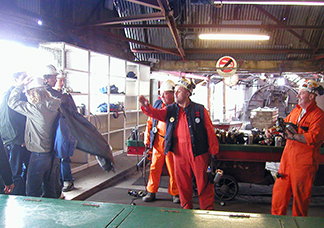
The Big Pit is a retired coal mine, no longer in use. But the Welsh Assembly Government decided that people ought to see what the lives of miners were like.
This is one of the few museums of this type anywhere that are completely free to visitors. Earlier, we had visited Cardiff Castle, the home of Welsh aristocrats. The contrast between how the rich and poor lived was stunning!
We shuffled into the elevator and descended the shaft with a mixture of excitement and trepidation.
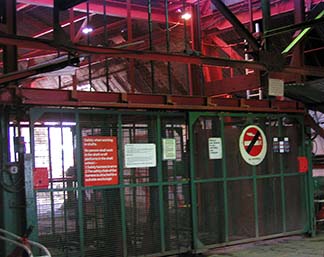
Down in the mine, we moved slowly through passages as the guide explained how coal was loosened with controlled explosions and knocked out with pickaxes. We kept banging our heads against the low beams. Glad we had hard-hats!
At one point, we saw compartments hewn out of the rock where small horses were stabled until as late as 1970. They were used to pull the carts of coal. Once the horses were brought down to the mine, they never came out to see daylight. Sorry, no photos of the mine. Cameras with batteries are not allowed! So you can see our tour guide only in the photo taken before the descent.
The guide explained that the doors between the passages were for safety – to assure ventilation and keep dangerous gases from spreading. Since the mine is not working, there are no gases there, so visitors don‘t have to worry, but we followed the drill. In the bad old days, little children would sit at the doors and open them for miners when the miners‘ lights signaled that they were approaching. Otherwise, the children sat for 10 and 12 hours a day in pitch darkness.
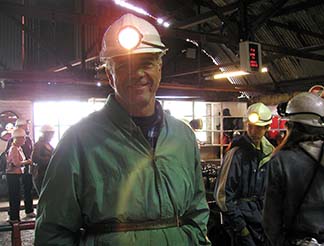
The guide told us to turn off our helmet lights to see what that was like. Frightening! The struggle for child labor legislation against the opposition of the mine owners suddenly took on dramatic new meaning.
The tour takes an hour. You can’t take photos in the mine, because the physics forbids it — you don’t want to set off an explosion. Afterwards, you can go to an excellent sound and light exhibit that moves you through passages and rooms as you hear “voices” act out what happens in a mine. But nothing compares with walking through the mine.
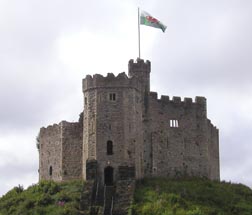
So, how did the other half live — the people who made their fortunes from the mines? You get a good picture at Cardiff Castle, a huge, sprawling, walled enclave with an elegant 19th century Victorian palace and a medieval “keep” built by the Normans to watch for marauders.
The buildings are on the site of a 2000-year old Roman fort. The palace was constructed by John Patrick Chrichton-Stuart, the third Marquis of Bute, one of the richest men in the world at that time. He got his money from his father, the second marquis, who became immensely wealthy in the mid-1800s after he built docks to move coal from the valley mines. By the early 1900s, Cardiff had become the world‘s major coal-exporting port.
As at The Big Pit, there‘s a guided tour of the 19th century palace. But you don‘t need a helmet to climb the “keep” or wander through the rooms of elegant furniture, paintings and murals, of fantasies created to emulate Provence in France or Arabia. I enjoyed seeing the beautiful rooms, but after I‘d visited The Big Pit, I couldn‘t help wondering about the mine workers – and children – who had paid for this luxury.
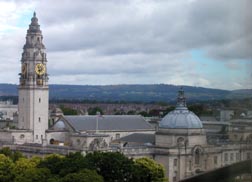
Times, of course, have changed, and now both mine and castle are tourist attractions! Politics aside, Cardiff is a charming little city, with an elegant classical civic center which includes the National Museum and Gallery, the University, the City Hall and Law Courts, all in white stone and pillars. And perfectly located, right between the civic center and the castle, is the Hilton Cardiff – from where I snapped a photo of the civic center.
I could also gaze at the castle from the window of my room. In Cardiff, views can be stunning, and the Hilton very smartly set a terrace restaurant facing the castle, so you can have breakfast and other meals while enjoying the view.
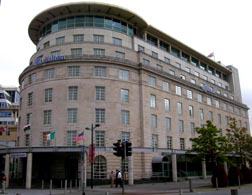
Inside, there‘s a trendy bar. The hotel also has an executive club, with complimentary drinks and snacks for residents of the executive floors, and of course a spectacular view. And there‘s a fitness center, a gym, swimming pool, sauna, steam room and two beauty salons.
Just the thing after a hard day in the coal mines.
Hilton Cardiff
Kingsway
Cardiff CF10 3h
Wales, UK
Tel 44 (0)29 2064 6300
Fax 44 (0)29 2064 6333
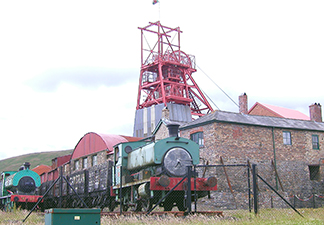
The Big Pit
National Mining Museum of Wales
Blaenafon, Torfaen NP4 9XP
Wales, UK
Tel 44 (0)1495 790311
Fax 44 (0)1495 792618
bigpit@nmgw.ac.uk
Open mid-Feb. to Nov 30.
7 days a week 9:30 am to 5 pm.
Underground tours 10 to 3:30.
There are lockers for watches, bags & backpacks.
Wear warm clothes and non-slip shoes.
Entrance free
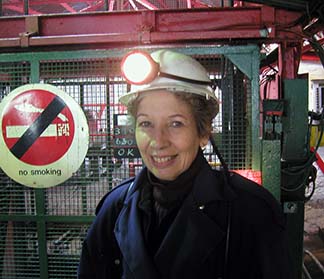
Tel 44 (0)2920 8781 0044
44 (0)29 2087 8100
Fax 44 (0)29 2023 1417
Castle Street
Cardiff CF10 3RB
Wales, UK
cardiffcastle@cardiff.gov.uk
Entrance £6.50, kids & senior discounts
Tourism information
Visit Cardiff
Visit Wales
Cardiff Gateway Visitor Centre
The Old Library, The Hayes
Cardiff CF10 IWE
Wales, UK
Tel 44 (0)29 2022 7281
Fax 44 (0)29 2023 9162
visitor@thecardiffinitiative.co.uk
open daily
BritRail
We took the ferry from Rosslare, Ireland, and arrived in Fishguard, Wales. From there, it‘s an easy train ride to Cardiff. With a BritRail pass — 4-days of travel in two months for $265 – we could stop there for a day, then continue on to England, visiting in Bath, Colchester (Essex) and Cambridge, and ending up in London. The pass is available only to non-residents and must be purchased before arrival in the UK. Prices vary for youths, seniors and first class. For information, BritRail. Or 866-BritRail.


I am a great grandaughter of a coal miner named Thomas from Tredegar. I once saw the most beautiful painting of coal miners just outside the mine having what looks to be their lunch with some children. I have searched and searched the internet trying to find that painting again and can’t. I don’t know the name or the artist…just thought I’d start asking others if they possibly know which picture I mean and more about it. Thanks so much.
Jamie Black Swisher